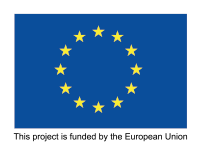
The preparations for the project started in 2016 and the program officially began in March 2017. BİRLİKTE was a project we announced with such excitement, continued developing at every step of it, tested and asked ourselves tirelessly "How can we do better?". We wanted to make a change and realize that change together with our 42 companions.
As of the end of November, after two years of intensive work, BİRLİKTE Program is coming to an end. At this stage we wanted to talk about BİRLİKTE program with our colleagues who implemented it since this project -from its design stage and the evaluation of the applications to its implementation, denotes an important experience for civil society in Turkey.
Here at STGM we value learning from each other and sharing our experiences. This long interview is an example of this. We hope that this long conversation, telling our experience in BİRLİKTE will provide inspiration, ideas and information to organizations.
Enjoy reading it.
“BİRLİKTE was designed as a contribution to the exercise of freedom of association.”
BİRLİKTE’s story spanning over four years is coming to its end on 30 November 2020. To begin with, we would like to hear about the background story of BİRLİKTE. Could you please explain the underlying factors that brought you towards BİRLİKTE?
Tezcan: Since its establishment in 2004, in addition to regular capacity building supports to civil society, STGM has implemented grant schemes for supporting CSOs and civil activists. These grant schemes were always regarded as a contribution to the exercise of freedom of association, of which fundraising is an essential component.
It is well known that grants and donations are two major sources of income particularly for CSOs operating with a rights-based perspective in Turkey. STGM’s vision is a stronger and more democratic civil society, and in line with this vision, it is crucial for us that the available grants should better serve for strengthening CSOs as autonomous and independent actors without questioning and harming their autonomy. For that reason, the grant schemes implemented by STGM for almost 15 years were designed to serve as tools for contributing to the exercise of freedom of association, including fundraising as a legal right.
We can state that BIRLIKTE is the most extensive and refined product of these endeavours. Ten years of experience between 2005 - 2015 gave STGM the ability to gather substantial lessons learned on how to design a more relevant financial support mechanism that will better serve the goals that I have mentioned above. At the end of the day, these crucial aspects came to the forefront: pursuing a wholistic approach in the design of the support, flexibility in procedures, targeting that the grant better serves the grantees’ mission, spanning the support over at least the mid-term and embracing methodologies that enable collective learning. BIRLIKTE was designed upon these major findings and founding principles.
These priorities may be easily defined, however reflecting them to the design of a EU grant project is difficult. When we were passing from IPA I to IPA II phase in 2014, there was a restructuring in terms of the management of civil society support schemes. This gave us the opportunity and courage to confront the new situation by initiating a rather unprecedented endeavour in terms of EU grants. We brought together all the lessons learned we collected up until then, prepared a report with our suggestions for improvements and shared it with the Delegation of the European Union to Turkey (EUD) in 2015. We received a highly generous and farsighted response. That was the groundwork that led us to the creation of a special support programme for local CSOs, which was later entitled as “BIRLIKTE” with the suggestion of our Management Board. Tuğçe may take over from this point, and give some details about the special characteristics of BIRLIKTE.
Tuğçe: STGM has an extensive track record and hands on experience in terms of implementing grant schemes for CSOs, particularly for local CSOs. BIRLIKTE can be considered as the most recent outcome of this entire process. In 2008, I joined the STGM team by taking part in technical assistance and monitoring of the grant schemes being implemented by STGM then. Even then, the search in STGM for simplified and alternative programmes, which will be potentially more relevant and effective in answering the needs of local/grassroots CSOs, had already started. As part of these endeavours, we worked in close cooperation with the EUD and CFCU for initiating a particular approach and designing a special grant scheme for local/grassroots CSOs. As a result of those efforts, between 2009-2011, we designed and successfully implemented the “Empowering Civil Participation at Local Level” grant scheme, with simplified application and budget formats and with a derogation that was allowing for applications in Turkish. As Tezcan underlined as well, BİRLİKTE should be considered as the end result of a long process and prior efforts.
Throughout time, in addition to the need for simplification of applications and implementation rules, another major need emerged as an important priority for civil society grants: general operating grants, or core grants as an alternative to action grants. When we set the stage for BİRLİKTE during 2014-2015 term, provision of general operating grants for CSOs in Turkey was very limited, and even non-existent in EU funded available grant schemes. STGM regularly shared the results of regular need analysis of its target groups with key actors and donors, and advocated for better alternatives. As the key actor and donor, the EUD and particularly the colleagues from the civil society team recognised these needs and cooperated with STGM for the initiation of an alternative solution.
When compared to action-based grants, delivering, implementing and assessing results of general operating grants is regarded to be more challenging by donors. With BIRLIKTE; STGM has obviously embarked on a more compelling process when compared to its previous grants. However, by the end of the Programme we strongly believe that with the results obtained BİRLİKTE has proven to be highly relevant and effective with its content, methodology and tools in terms of meeting the needs of the target group. As a flagship program, BIRLIKTE has turned out to be a model and inspiration for other peers and donors, and served for the promotion of general operating grants as an alternative mechanism to project grants.
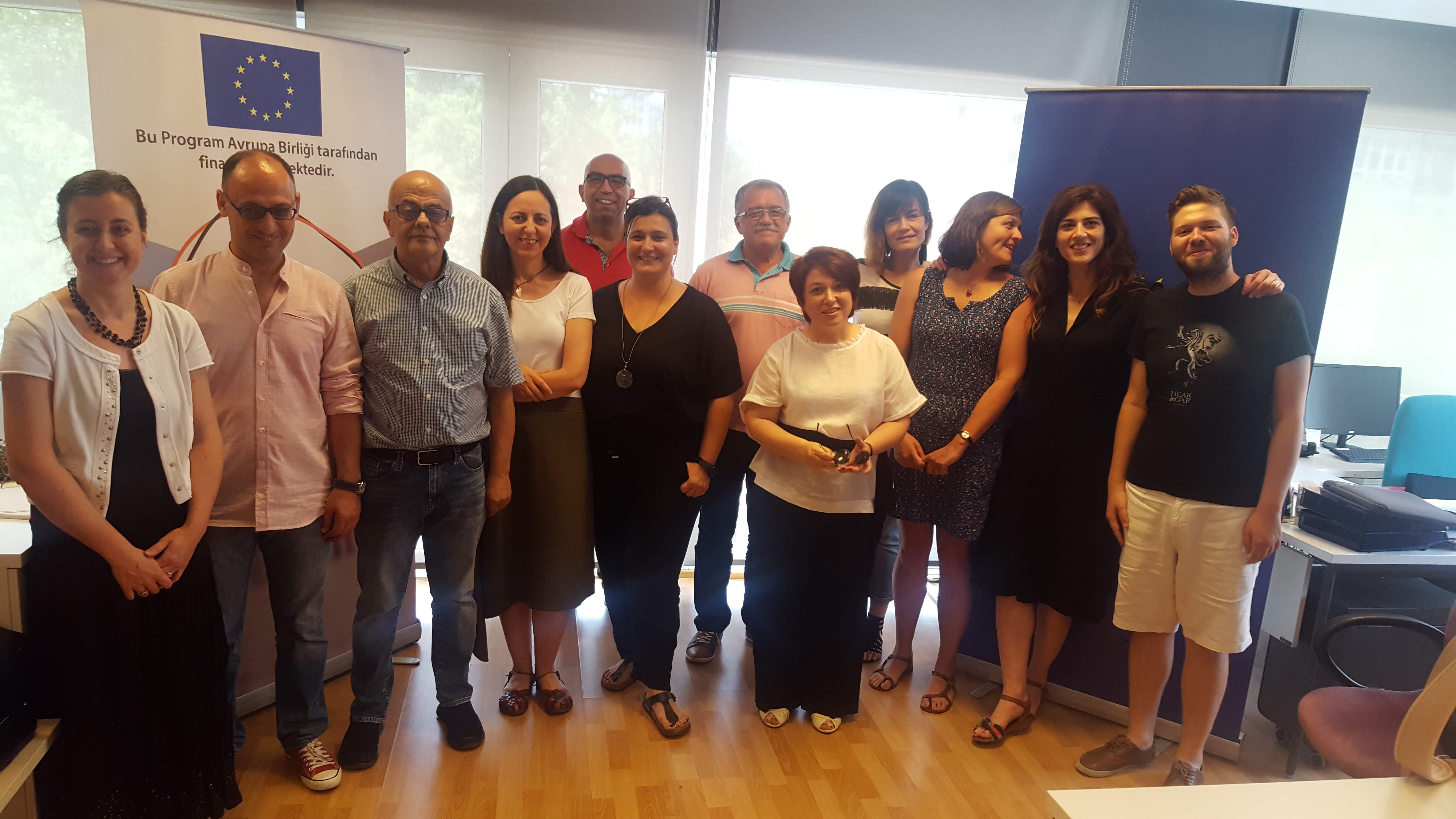
“The most distinctive aspect of the evaluation process was the “face-to-face interview(s).”
BİRLİKTE open call for proposals drew great interest of civil society organizations in Turkey and the program received over 400 applications. If we go back two years, can you tell us a little bit more about the evaluation phase? How did the evaluation process proceed?
Tuğçe: With BIRLIKTE, STGM gathered several different mechanisms together and implemented them for the first time. It is the first sub-granting scheme at this scale, the first general operating grant support with EU funding and the first grant scheme with a one-to-one mentorship support scheme. With all these novelties, the evaluation of applications was on its own a huge experience considering also that we have further introduced some novelties to the standard evaluation processes of EU grant schemes.
We have received 419 applications by mail and post. For that reason, the very first challenges we had to cope with were things like duly accepting, recording, classifying and physically maintaining the applications at the office. Our main advantage during the evaluation phase was our highly qualified and experienced team of external and internal assessors. Thanks to their high level of ownership and motivation, we successfully completed such a labour-intensive process without any major problems. Another positive factor facilitating the evaluation process was that the application package and the evaluation grids we designed for BIRLIKTE worked successfully and effectively at the practical level. Leaving aside noting down several issues for potential improvements in future programmes, the evaluation tools generated successful results for the evaluation phase and received very positive feedback from the users.
Zeynep: The most distinctive aspect of the evaluation process of BİRLİKTE was the “face-to-face interview(s)”. As far as I know, before BİRLİKTE in no other EU grant programs face-to-face interviews were used as an instrument of evaluation.
Once the desk reviews and evaluations of applications were complete, 75 civil society organizations were shortlisted for the second phase. Consisted of one internal and one external assessors, two-person teams visited the applicant civil society organizations at their offices or sites and conducted semi-structured interviews. We have seen that when well-designed, interviews can become effective instruments in selecting relevant CSOs, those that meet the program criteria and requirements. This interview phase became a quite unique and informative process for the assessors.
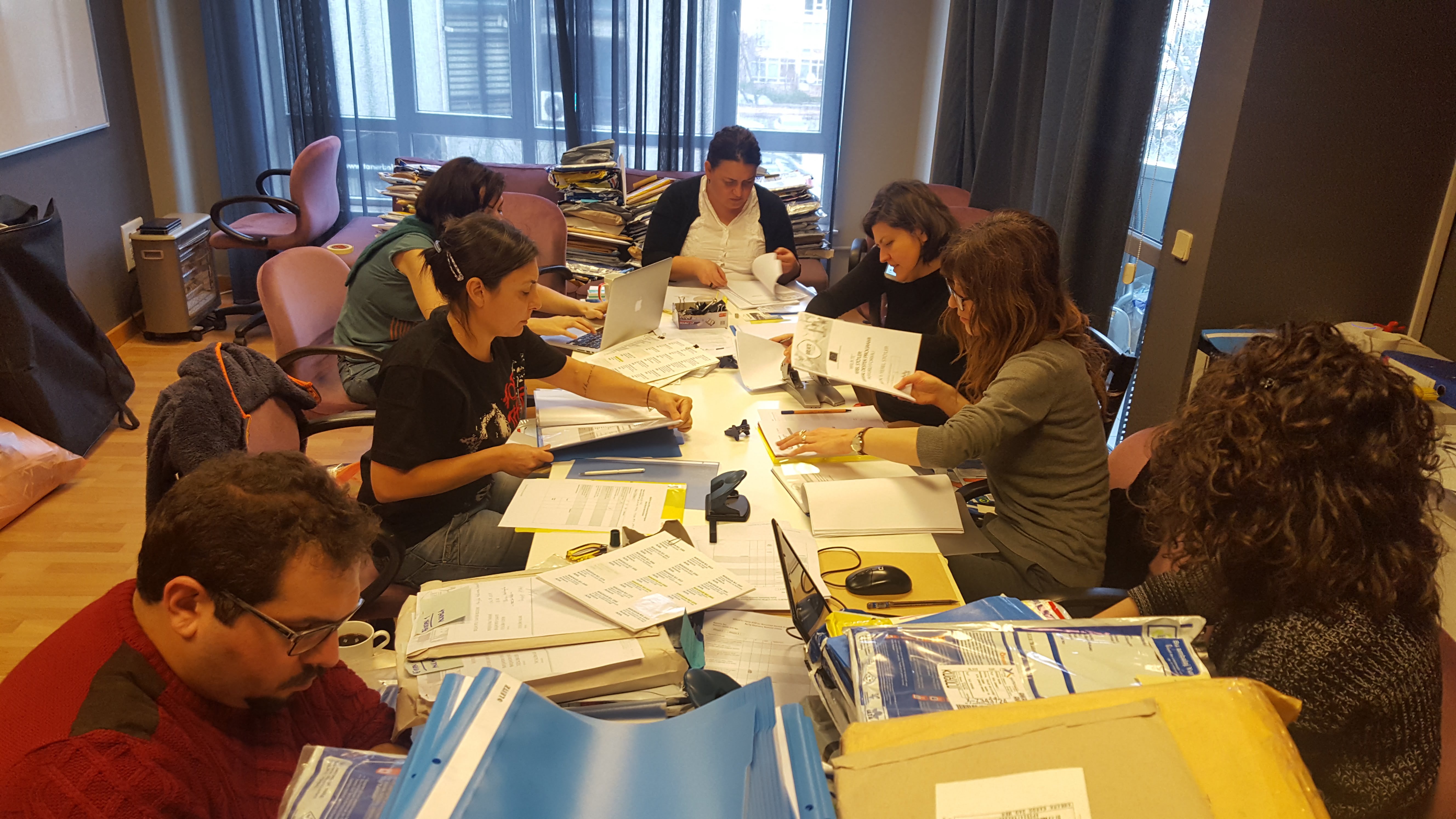
As result, 42 civil society organizations were selected as beneficiaries of the program. We are aware of the difficulties/challenges of selecting those CSOs out of 419 applications. Can you tell us a little bit more about the evaluation process? Which themes were more common? Which criteria became important/effective in determining the CSOs that are eligible for the program?
Gülbanu: Me and Zehra participated in the program as external assessors at the beginning; the offer for our involvement as mentors came up later, after the evaluation committee announced the list of selection. We were invited to meetings explaining the purpose of the program, the process and evaluation criteria and were provided with guidelines and other documents necessary for the evaluation. At that time, I remember thinking to myself what meticulous and attentive work the team members did for preparation and planning of the process.
The files containing the applications were carefully organized; they were being delivered and collected in an order during the evaluation. I remember the continuous flow of traffic between the rooms of evaluation and of the team and even though the number of applications was huge, because of the well-organization we did not experience any difficulties during the evaluation process. It was both a professional and a pleasant work environment, enabling us to do our best to understand and evaluate the applicant civil society organizations well. All of 8 independent/external assessors conducted the first phase, evaluation of application forms and organizational documents in line with the criteria previously defined. Among those criteria were CSO being a rights-based organization, the consistency between the CSO’s mission/vision and its activities, level of impact in its field of action, organization’s engagement with different forms of rights-based activities or addressing multiple forms of inequalities and their willingness and plans for institutional capacity development. During the evaluation process we tried assessing those that meet the criteria and those that would benefit the most from the program to be more effective in their field of action/intervention. Then the second phase of the evaluation, face-to face meetings began…
Zehra: The evaluation process was difficult since each of us undertook a big responsibility of assessing which among those many civil society organizations, conducting valuable work in their own fields of action, would benefit from the program. This was especially the case since there were more than 400 applications to the program where only 42 shall be selected. We kept reminding ourselves that our job is not to assess the best/good CSOs but those that are most suitable for the program. The very well-designed nature of both the evaluation process and instruments made things much easier for us.
There were many evaluation criteria we were taking into consideration. It is hard to explain all of them here, however when I look back I can say the most important was the impact. It was quite important to see that the civil society organization knows what it wants to change in the field and its activities are coherent with that objective, clearly in the applications. What differentiated these CSOs from the others was not the size of their budget or how many or different types of activities they were conducting rather the change they would like to bring and the efforts they put in in realizing that change. Later, we found out that not only us but also the organizations faced a challenge. I can say it with confidence because many of the applicants provided such feedback. The beneficiaries told us that the impact of BİRLİKTE was felt even at the phase of filling of the application form. They said, “we asked questions to ourselves that we never asked before, we x-rayed our organizations.”
Another distinguishing criterion was the insight the CSOs had for the notion of institutional development. Those organizations which were aware of such a need, knew their strengths, had an opinion about the areas that need development and knew which areas need particular focus came forward during the evaluations.
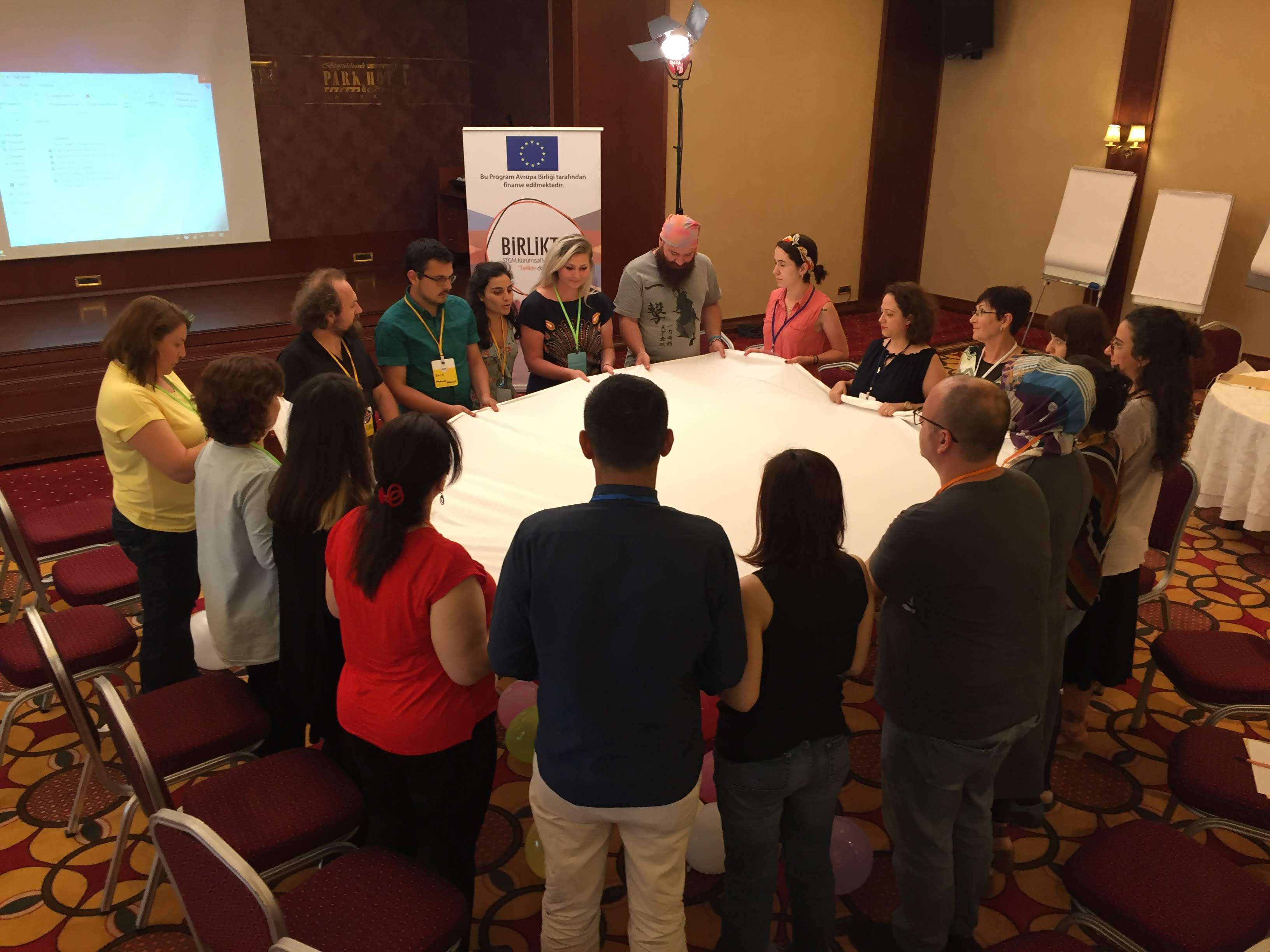
“In the design of BİRLİKTE we focused on two essential needs of civil society (organizations)”
BİRLİKTE became a program that brought in many innovations. From its design to the implementation you focused on the objective of creating change in many areas. Can you tell us a little bit more about that change based on the feedback you received from the beneficiaries/CSOs?
Aysun: STGM has been working for civil society organization capacity development for many years now. In designing BİRLİKTE program we aimed to translate that experience and most importantly to address the needs we assessed in civil society. For that matter we focused on two aspects: core grant support and institutional capacity development support.
An important aspect of the institutional capacity development program is the Capacity Development Model, designed again with STGM knowledge and experience in the area. We formulated the model and defined the process of implementation in detail long before we went to the field and started working with beneficiaries. The capacity development process was initiated with self-assessments, accompanied with trainings, supported with continuous mentorship, and regularly held peer-to-peer meetings for two years. Organizations reported that with self-assessment they held a mirror to their systems and were able to assess the level of their institutionalization from a distance and with a more objective view. Being wallowed in activities sometimes, they told that they overlooked the chance of assessing themselves, their objectives and long-term goals. Self-assessments enabled such an analysis and the formulation of improvement plans. We have realized many improvements with the beneficiaries within the scope of those improvement plans.
Organizations also reported that they were able to establish some systems collectively and even beyond their expectations. Especially in areas such as governance, financial sustainability, strategic planning, communication, digitalization, correct assessment of necessities and objectives systems were formulated or improved in a collective manner. With custom made improvement plans, implementation and monitoring of such plans, trainings and peer-to-peer meetings, our beneficiaries stated that BİRLİKTE broadened their vision and contributed to their development.
The core grant support enabled the organization to focus on their field of action and to allocate time in working on the improvement of systems and methods for financial and institutional sustainability. Without having to worry about finances for staff, office and other expenditures they were able to concentrate on their organizational systems with BİRLİKTE support. All in all, the program contributed to the empowerment of not only the organizations but also of civil society.
Gülbanu: BİRLİKTE aimed at achieving organizational capacity development through core grant, mentorship and communication support. The most important aspect of the program is that such support lasted for two years; the relationship established with our beneficiaries was continuous, close and prompt and nonhierarchical. Along with trainings, modules and guides provided to the beneficiaries, the mentorship program enabled the organizations and mentors to work together, plan, implement and monitor improvements. Each mentor communicated with their organizations, visited their offices on a regular basis and followed the developments at organizational levels.
Another important feature of the program was the self-made nature of the improvement plans. The analysis which are called as “self-assessments” were conducted (three times, one at the beginning, second year and at the end of the program) at each organization and with the participation of members from staff, board and/or volunteers. BİRLİKTE beneficiaries assessed the areas such as communication, finance management, governance and decision-making that need improvement and they defined the specific solutions or interventions for organizational development. We have provided guidance through provision of materials, experience, information and examples of good practice to our beneficiaries for the formulation or improvement of systems.
The third characteristic that makes BİRLİKTE unique is its definition of the program as a continuous and mutual learning process. Our 42 beneficiary organizations came together regularly at trainings and most importantly at peer-to-peer meetings and shared their experiences. Good practices in areas such as transparency, fundraising or volunteer management were shared for collective learning, improvement and collaborations. The two-year-long journey of learning and collective work was appraised quite highly by our beneficiaries. The program and the mentorship satisfaction surveys revealed 90 percent and 98 percent of satisfaction rate respectively. We received more oral and written feedback from our beneficiaries on BİRLİKTE’s impact on their organizations. They have expressed that BİRLİKTE provided a vision for activism and organizational development, contributed to the planning of organizational structure and work, formulation of financial and administrative processes and to monitoring. While before the program the term institutionalization was understood as bureaucratization or corporatization, it has come to be conceptualized in relation with participation, accountability, transparency and a requirement of establishing standards and norms for collective action.
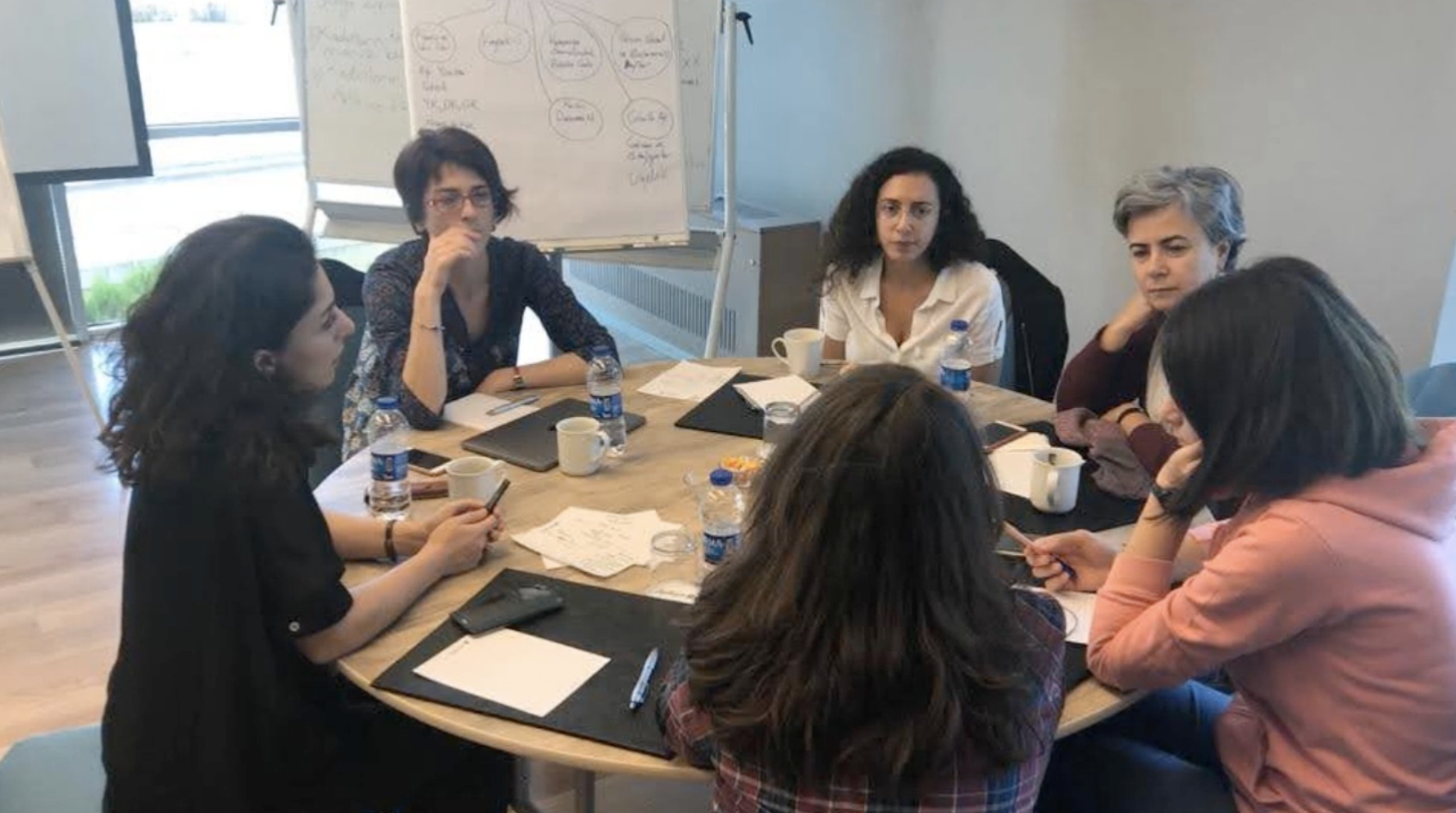
“We acted shoulder to shoulder and stood tall at times of stumble”
BİRLİKTE has a motto #letschangetogether. In order to initiate and facilitate change at 42 organizations as a team of 9 person you worked together in the same room. Each of you have a different background and experience in diverse fields of civil society. How did you experience this? Can you tell us more about your collective work and how you brought your work together?
Aysun: All the way through the program at our biweekly held team meetings we put the issues, events and questions we came across on our agenda and discussed them together. We worked through the capacity development model and the modules together in order to standardize the quality of work at the most possible extent. We held a series of team workshops, discussed the concepts and contents and consulted other experts whenever we needed such support.
In order to formulate a common language and understanding among mentors we also organized regular training. Some of those trainings were on technical subjects such as fundraising some of them were thematic, such as mainstreaming rights of people with disabilities. The team participated in all of the meetings and trainings held for the civil society organizations as well and had evaluation meetings in the aftermath of such organizations.
Gülbanu: Working with eight other people was a first-time experience for me since before BİRLİKTE I worked in research teams of three or four colleagues. I think our team was unique in terms of its composition and interaction and this uniqueness had an impact on BİRLİKTE’s effectiveness.
Yes, we were a team of people with different experiences and knowledge but each of my teammates were quite generous in sharing their experiences and bringing in their expertise in our common work. It was possible for me to consult, ask their opinion and discuss issues I came across; thus the last two years have been a learning experience for me too. As a team we had standard and regular information sharing environments such as regular biweekly team meetings, trainings, planning and evaluation meetings for events or file systems, the possibility of instant sharing and communication, however, made things much easier. Working in the same room we have had the opportunity to talk and discuss at the site and at the time it is necessary.
Our room was loud at times but was mostly joyful and dynamic. We shared the work we are conducting with organizations, asked each other’s opinions or worked together with the same organization. You know there have been lots of studies on the impact of Covid-19 pandemic at social, economic and personal levels. I think the most dramatic impact Covid-19 on BİRLİKTE has been, apart from the inability of visiting the beneficiaries, was the interruption of working together in the same room.
Tuğçe: One of the most important factors that makes STGM and especially BİRLİKTE a very special work experience for me has been the colleagues I found the opportunity to work with.
The solidarity, sense of ownership (of the work) within the team and the team spirit made it possible to come through the hard work and ensure professionality along with lots of laughs and joy. I believe in the power and energy of names. In that sense, BİRLİKTE/TOGETHER was a work true to its name.
Each of our team members have different strengths and experiences in civil society. We have succeeded in translating those strengths and experiences to the program at the maximum level. We complemented each other and learned a lot from each other, as well as from the beneficiary CSOs. In addition to our regular team meetings, whenever an obstacle, an important issue emerged, we came together to discuss and generate solutions in a collective manner. I strongly believe that this has contributed a lot for strengthening the ownership of the entire team. Of course we experienced many difficulties as well, but we acted shoulder to shoulder and stood tall at times of stumble.
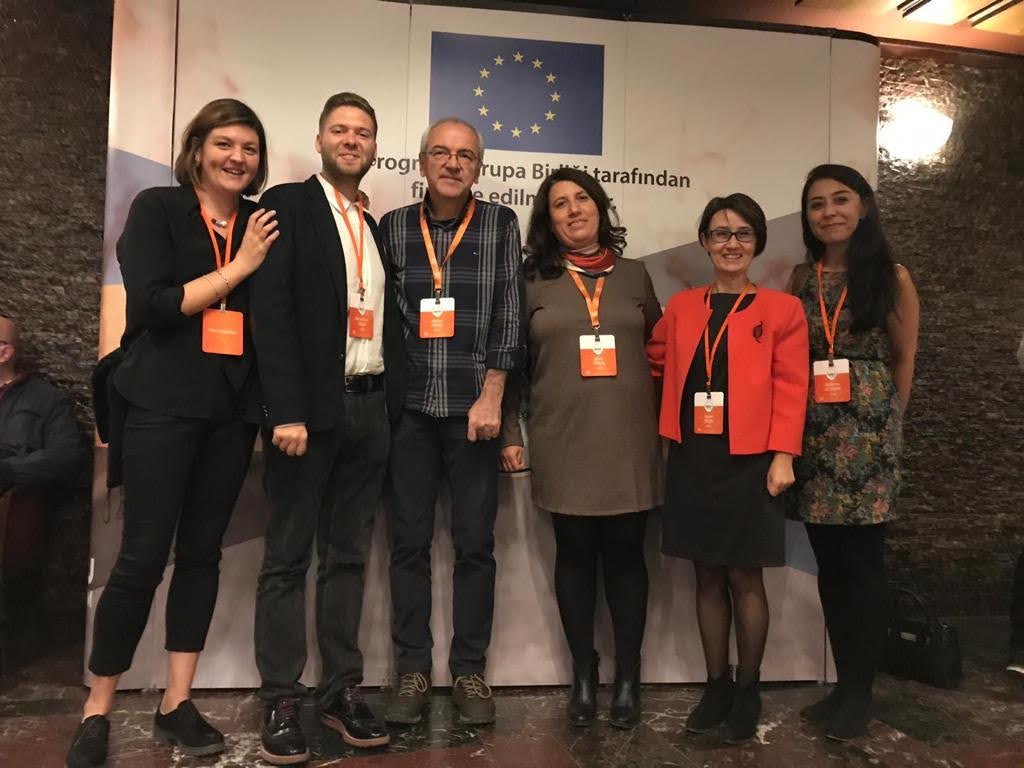
“We have overcome every challenge with solidarity”
Akça: BİRLİKTE has been the most crowded/large team I have ever worked with as well. Considering the fact that in my earlier positions I was working in teams of 3 people at most and alone in my own room, I have to say I was a little bit worried in the beginning.
As a finance coordinator I had to pay utmost attention/concentration to my work, there was the weary impact of the laborious task and how about the possible conflicts within the team. Shortly afterwards my worries dissolved and I discovered that working with such a team is quite instructive and fun at the same time.
Having the opportunity to exchange ideas with each other beyond regular meetings, to ask opinions about a question you have in your mind to the person sitting next to your desk was a great chance. We worked with a real team spirit and a feeling of belonging. Subgranting is a specific type of support with its own challenges and along the way we encountered many others such as the exchange rate crisis that erupted in 2018 and the following Presidential Decree restricting contracts and any other payment obligations denominated in foreign currencies. Yet we have overcome every challenge with solidarity and most importantly with laughs. As much as the thorough design of BİRLİKTE program and its instruments made our work easier, at the end of the day I can say with certainty that it was my teammates that I am going to miss working with, made the difference.
Zehra: At BİRLİKTE we did not (provide) mentor support to the organizations only but also to each other. I worked with the most understanding and supportive team, each member of which having great knowledge and experience in their respective field of work. We also benefited from STGM’s long-time experience and knowledge in the field and received support from other STGM colleagues. We have implemented the program, which was innovative and ambitious in many respects and hence a little bit intimidating and fulfilled it with success even up against the pandemic conditions. I do not feel like we are finalizing a Project rather like I am graduating from a school.
Apart from our love for coffee and chocolate, I think the most important thing about the team was the sharing the responsibility of the program by each of us. Having various types of encounters and engagements with civil society organizations, each member of our team was very well aware of the importance of a program that is providing support to local CSOs and focusing on institutional development. Besides, the mentorship program was designed in its smallest detail; everything, including the ways of communication and sharing of our knowledge, documents and experiences, was “defined.” “Defined” was one of the words we all used to and liked to say during the program. We were always in touch and stand together in the ways my colleagues have already expressed.
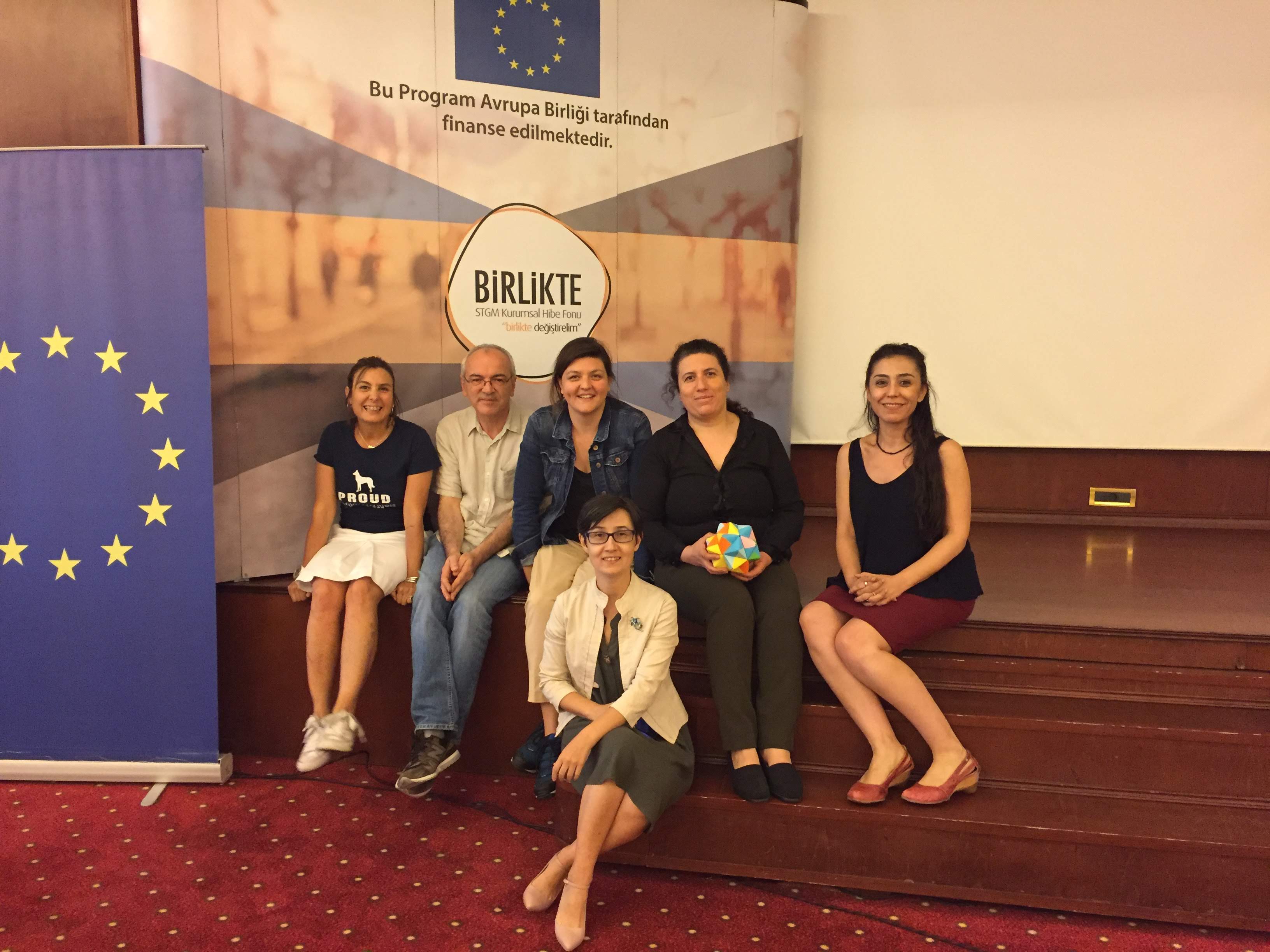
“There were times when I woke up in the morning and couldn't remember which city I was in”
You worked thousands of hours with representatives of the beneficiary organizations and travelled the equivalent of three times around the world. These figures are quite high for a two-year period. Can you tell a little about that? What kind of processes did you go through as a team? We would love to hear interesting travel stories, if there are any.
Nevzat: Within the scope of the program, mentors were assigned with the task of conducting seven field visits to each beneficiary organization. The organizations are scattered all around Turkey; 12 of which are based in Istanbul, 8 in İzmir, 4 in Ankara, 3 in Eskişehir and 2 in Bursa. The remaining ones are located in Kırklareli, Tekirdağ, Düzce, Samsun (Bafra), Trabzon, Denizli, Antalya, Adana, Balıkesir, Diyarbakır, Mersin, Giresun, Kars. Thus, apart from the visits, visit planning has become a tough task in itself. In order to ensure the highest possible level of participation by members of the organizations, it was necessary to find the most suitable time for everyone vis-a-vis the most suitable travel routes and means. When these visits are considered together with the training programmes, mentors have spent almost one month every three months on the road. As a result of these frequent trips to different cities either by plane, bus or train, there were times when I woke up in the morning and couldn't remember which city I was in.
During these field visits, which started with introductory visits and continued with self-assessment visits, it was possible to work in detail on the improvement plans of the organizations. It was very pleasing to see our friends in the organizations we work with at regular intervals. During this period, we witnessed the problems experienced by organizations especially at local level, and saw how important mentoring and the institutional grant support is for organizations which carry out rights-based activities at the local level.
As a result, each of us has connected to the organizations we work with almost as if we were members; I can easily say this for all my mentor friends. On behalf of the BIRLIKTE team, I would like to thank all representatives of the beneficiary organizations, who devoted their time and efforts for visits and organizational improvements and sincerely participated in our work. The field visits were exhausting, but online meetings that started with STGM's suspension of face-to-face meetings as of March due to the Covid19 pandemic have become even more exhausting for us and the representatives of the organizations we work with. Training events or visits, which would have taken one day if conducted face-to-face, have been extended to cover one week when the meetings were held online. Despite the difficulties of online meetings, which we all experience and go through, it's nice to see friends and hear about their work.
“I’d rather have another round of tour around the world than attend online meetings”
Gülbanu: I consider myself relatively lucky compared to my other friends, as the organizations I work with are grouped in İstanbul, İzmir and Düzce, and I travelled to these three cities. But we all experienced similar challenges, such as difficulties in planning meetings and travels, attending meetings without any break, getting out of one meeting and preparing for the next one in a hotel room, focusing on a completely new topic for the meeting next day, trying to catch the plane or train right after the meeting and so on. We were out of the office and on the road for long periods of time, sometimes for more than one month. Returning from travels, we saw each other at the office and cherished the reunion. Rarely, we had the opportunity to be in the same city with our teammates, and we tried to meet on these occasions. Even though travels can be exhausting at times visiting the beneficiary organizations had its own pleasure.
We had the chance of working and planning together, following and at times participating in our beneficiaries’ activities. Witnessing and being part of efforts for the elimination of inequalities, empowerment of target groups in their access to rights and services was fascinating. As Nevzat has well-put, I’d rather have another round of tour around the world than attend online meetings.
Aysun: Due to our heavy travel schedule there were times I confused the cities. I remember several instances where I told the taxi driver the address, received the answer “there is no such place here” and realized that I confused the city I am in again. I was able to end up in the right place in the end and held the meetings of course. Another difficulty was the exposure to air conditioners in buses, airplanes and hotels. Since I have allergic asthma I had to deal with asthma problems when I returned from travels. Yet still, I think seeing all the improvements and eventual change in our beneficiary organizations helped us all in bearing such difficulties.
